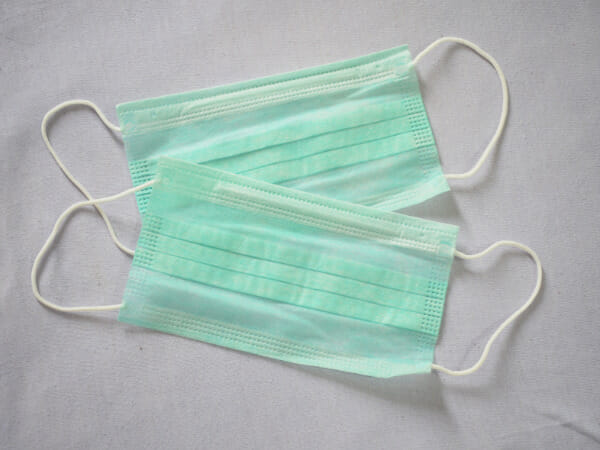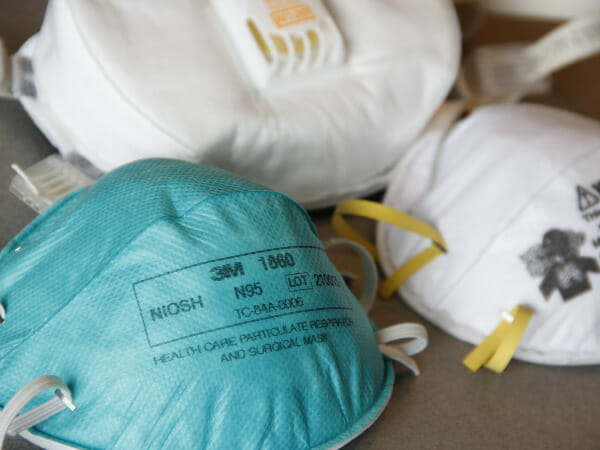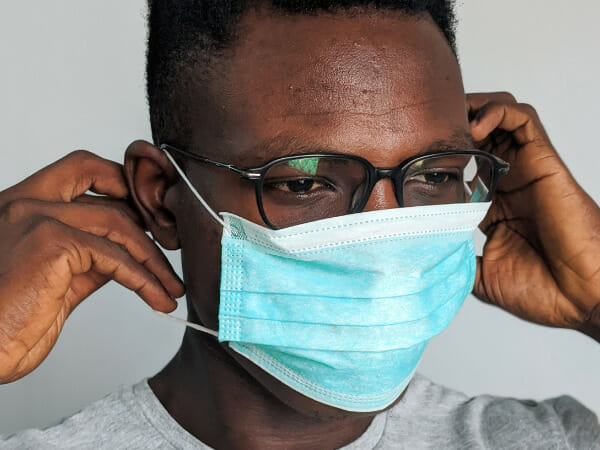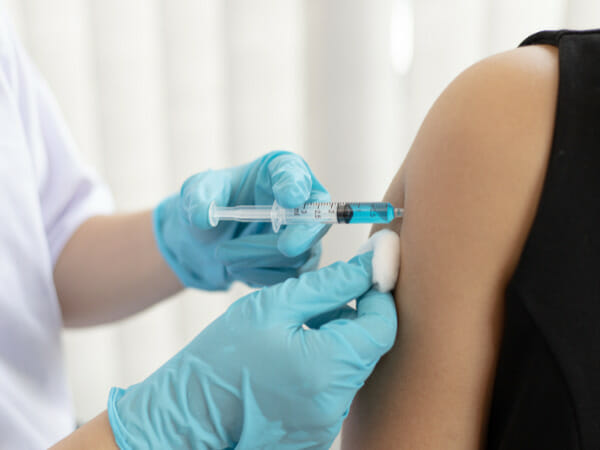N95 vs KN95 – which face mask is safer?
When people need the best protection against COVID-19, they compare N95 vs KN95 face masks. They fit snugly around your nose and mouth, so you’ll have a tight seal around them. There are so many N95s and KN95s out there and other types. All these choices can be overwhelming for most people.
Some people don’t see why they’re important, so they settle with the usual blue surgical masks. Yet, people need N95 respirators more than ever to reduce the new coronavirus variants risk. Fortunately, this article can help you find the right N95 and wear one properly. It will share tips that summarize the CDC recommendations.
I’ll start by discussing why governments worldwide promote the use of N95 respirator masks. After that, I will compare N95 vs KN95 masks and explain why we even have other masks similar to the N95. Then, I’ll explain how double-masking can boost protection against COVID-19. I will also talk about the other things you need to do against the pandemic.
What are N95 and KN95 masks?

Let’s begin by talking about what the term “N95” means. The “N” is its Respirator Rating Letter Class, which means “non-oil.” This means you can use it if there are no oil particulates around.
Meanwhile, the “95” is the amount of 0.3-micron particles it will block out of every 100. This means an “N95” filters out 95 percent of particles, but there must be no oil present in the air.
If you shop online, you might have seen the KN95 face masks and other types that are supposedly similar to the N95. Those are from other countries that follow different standards.
The KF94 masks I mentioned earlier come from South Korea. However, the KN95 masks are more common and come from China.
The best choice between N95 vs KN95

As of January 14, 2022, the CDC clarified that people might pick respirators such as N95 and KN95s because of a shortage of the former. However, it had a few reminders about KN95s.
The National Institute for Occupational Safety & Health (NIOSH) reviewed documents from China-based face masks and found that many were falsified.
The CDC also recommended tips on choosing face masks that follow international standards. Wear them if they meet the following criteria:
- A proper fit over your mouth and nose to prevent leaks
- Several layers of non-woven material
- A nose wire (the metal bit over the nose part)
Moreover, here are the things you shouldn’t do when you have a mask that doesn’t meet standards from the United States:
- Continue wearing them if you’re having trouble breathing with them
- Keep using them if they are dirty or wet
- Wear them along with other respirators or masks
- Use it as a replacement for the NIOSH-approved mask required at your workplace
DYK? CDC does not recommend using masks with exhalation valves or vents. The hole in the material could let respiratory droplets that spread #COVID19 escape & reach others. More on masks: https://t.co/Z04PIIjjd8. pic.twitter.com/esJ8Xh8fJY
— CDC (@CDCgov) March 29, 2021
No matter your preference between N95 vs KN95 masks, you must make sure yours isn’t counterfeit. Here are the signs that your respirator might be fake:
- It has no marking at all on the filtering facepiece respirator
- it doesn’t have an approval (TC) number on the headband or the filtering facepiece respirator
- Yours has no NIOSH markings
- The acronym “NIOSH” is spelled wrong.
- It has a decorative fabric or other add-ons, such as sequins.
- The mask has labels that claim its approval for children. The NIOSH does not approve any type of respirator mask for kids.
- The filtering facepiece respirator replaces the ear loops with headbands.
Read More: Are Home COVID Test Kits Worth It?
Should you double mask?

Some people might have difficulty choosing between N95s and KN95s if there aren’t any available. That’s why many people settle for the common blue cloth masks.
I’ve said that face masks should fit snugly around a person’s nose and mouth. Sometimes, a person’s face might not allow for that secure seal.
This is why the CDC recommended double masking. As the name suggests, it involves wearing a cloth mask with several layers of fabric with a disposable one beneath it.
Start by choosing the right cloth mask and disposable mask. You could check online stores or a nearby pharmacy like Walgreens. Keep these in mind when picking a cloth mask:
- It should fit properly over your mouth, nose, and chin to prevent leaks.
- The mask should have several layers of tightly woven, breathable fabric
- It would be best if it had a nose wire.
- If you can test one at a local store, hold it up against a light source. It’s a good choice if no light passes through it.
- Your cloth mask should not have vents, valves, or other openings.
- It must not be made of dirty or damp material.
Given the shortage of N95 respirators during this global outbreak of #COVID19, it’s important to understand the difference between N95 respirators and surgical masks, and how both are intended to protect healthcare workers. Learn more from @NIOSH: https://t.co/rGGoSYmo30. pic.twitter.com/HJNQfoAWk9
— CDC (@CDCgov) April 22, 2020
Disposable masks are called procedure masks or surgical masks. Look for those if you can’t find disposable face coverings. Also, make sure yours meets the following criteria:
- Yours should fit over your chin, mouth, and nose to avoid leaks.
- It must have multiple layers of non-woven material.
- It’s also a good idea to find one with a nose wire.
- Don’t buy one that has gaps around the sides of the face.
- Don’t pick the ones that are wet or dirty.
Regardless of your choice between N95 and KN95 masks, they are not double masking. Once you have both, try wearing them both. If you still can’t get a good fit, you might need to trim your facial hair. There are two things you shouldn’t do when double masking:
- You must not wear two disposable masks at once.
- Regardless of your choice between N95 vs KN95 masks, they are not for double masking.
Get vaccinated against COVID-19

Aside from choosing between N95 vs KN95 masks, the most important thing to do is get fully vaccinated, especially because of the Omicron variant.
This means getting the initial doses plus a booster shot. This means getting two doses of the Pfizer or Moderna vaccine, or one from Johnson & Johnson’s Janssen.
After completing those, you must follow certain guidelines to get a booster. Here are the ones that apply to each vaccine brand:
Pfizer-BioNTech
- Everyone 12 years and above should get a booster.
- You must receive yours five months after completing your primary doses.
- It’s best to match your Pfizer shots with a Pfizer or Moderna booster. If you’re a teenager that’s 12 to 17 years old, you may only get the Pfizer booster.
Moderna
- Everyone 18 years and above should get a booster.
- You must get the booster five months after completing your initial doses.
- It’s best to match your Moderna shots with a Moderna or Pfizer booster in most situations.
Johnson & Johnson’s Janssen
- Everyone 18 years and above should get a booster.
- You must get the booster two months after completing your initial shot.
- It’s best to match your Janssen shot with a Janssen booster. Still, you could use a Moderna or Pfizer booster too.
You will need to present your vaccination card when getting the initial doses and boosters. In other states like New York, you might keep it in a smartphone app.
Other ways you can avoid COVID-19
The Omicron variant spreads more easily than the original virus that causes #COVID19. Help stop Omicron by using all the tools to protect yourself and others.
Learn more: https://t.co/wbu65L0mgM.
— CDC (@CDCgov) December 22, 2021
Let’s say you’ve completed your vaccine shots, and you’ve picked between N95 vs KN95 masks. Now, you should keep on following the other COVID guidelines.
This means staying indoors as much as possible, especially when you don’t need to go out. If you need to do so, make sure to practice social distancing.
Try to keep away from people when using any form of public transportation. This applies no matter the outdoor setting. Of course, you must wear a face mask while outside.
Practice proper hygiene by washing your hands and cleaning your stuff. All these measures are intended to minimize the spread of COVID-19 for you and other people.
Related Articles
Final thoughts
Follow the CDC guidelines to help in the fight against the novel coronavirus. If you’re not from the United States, follow the public health measures in your country.
At the time of writing, the Stealth Omicron variant is spreading worldwide. This means it’s much harder to detect than the original Omicron virus.
This new variant is classified as “under investigation” in the UK. Until we learn more about it, the existing COVID guidelines still apply.







